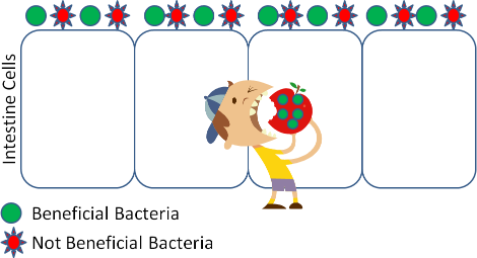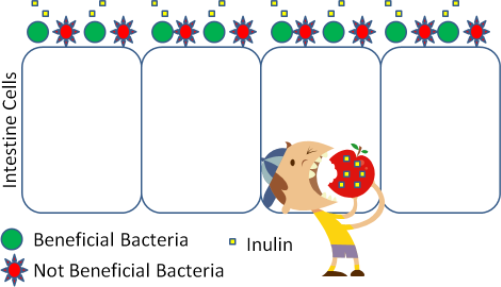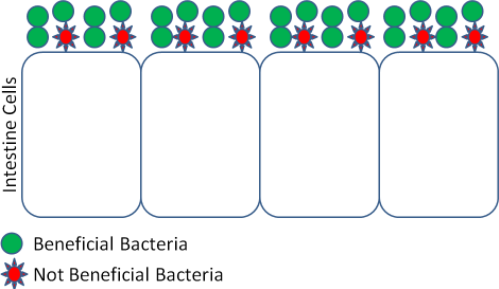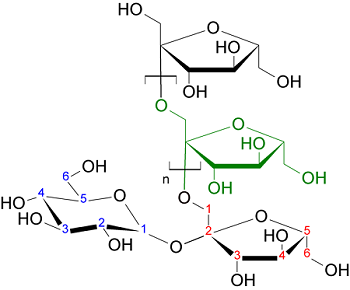3.6A: Probiotics and Prebiotics
- Page ID
- 1465
Recently there has been increased attention given to the potential of a person's microbiota to impact health. This is because there are beneficial and non-beneficial bacteria inhabiting our gastrointestinal tracts. Thus, theoretically, if you can increase the beneficial or decrease the non- beneficial bacteria, there may be improved health outcomes. In response to this, probiotics and prebiotics have been identified/developed. A probiotic is a live microorganism that is consumed and colonizes in the body as shown in the figures below.

Figure 3.6A.1: Probiotics the consumption of the bacteria itself
A prebiotic is a nondigestible food component that selectively stimulates the growth of beneficial intestinal bacteria. An example of a prebiotic is inulin, which is shown in the figure below.

Figure 3.6A.2: Inulin, an indigestible food component that is a commonly used prebiotic
The net result is the same for both prebiotics and probiotics, an increase in the beneficial/non beneficial microorganism ratio.

Figure 3.6A.3: An effective prebiotic or probiotic should result in an increase in the beneficial bacteria
The following video does a nice job of explaining and illustrating how probiotics work. The NCCAM website is a good source of information if you have further questions on the topic. Some common examples of probiotics are DanActive® and Activia®.
The Wonderful World of Probiotics. http://www.youtube.com/watch?v=2k8Puxz54FQ&NR=1
The claims that companies made about their produce probiotic products have come under scrutiny. Dannon settled with the US Federal Trade Commission to drop claims that its probiotic products will help prevent colds or alleviate digestive problems, as seen in the top link below. General Mills also settled a lawsuit that accused them of a falsely advertising the digestive benefits of Yo-Plus a product it no longer sells, as seen in the second link.
Some examples of prebiotics include inulin, other fructose-containing oligosaccharides and polysaccharides, and resistant starch. Inulin is a polysaccharide that contains mainly fructoses that are joined by beta-bonds, which allows them to survive digestion. The structure of inulin is shown below.

Figure 3.614: Structural formula of inulin (fructan). Additional features (carbon numbers and repeated fructosyl unit) are highlighted with colors. (Public Domain; Florian Fisch).
Resistant starch is so named because it is a starch that is resistant to digestion. As a result, it arrives in the colon to be fermented.
References
- Douglas L, Sanders M. (2008) Probiotics and prebiotics in dietetics practice. American Dietetic Association.Journal of the American Dietetic Association 108(3): 510.
Links
- NCCAM: Probiotics - http://nccam.nih.gov/health/probiotics/
- DanActive® - http://www.danactive.com/
- Activia® - http://www.activia.us.com/
- Danimals® - http://www.danimals.com/New Campaign Markets Activia to Wider Audience - http://www.nytimes.com/2014/01/06/bu...ence.html?_r=0
- General Mills Settles Yo-Plus Lawsuit - http://www.foodbusinessnews.net/arti...9E946D0}&cck=1


